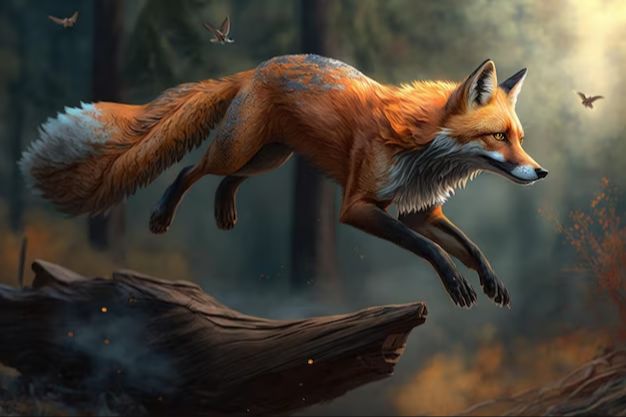Introduction
When imagining an altercation between a fox and a dog, it’s natural to wonder which animal would emerge victorious. This article will analyze the hypothetical scenario of a fight between a fox and dog by comparing their physical attributes, hunting abilities, agility, bite force, defensive tactics, and social structures. We will look at the key advantages and disadvantages each animal has in order to determine which one would likely prevail in a direct confrontation.
To set up the premise, let’s imagine a territorial dispute between a wild fox and a domestic dog that lives on an adjoining property. As they encounter each other, tempers flare and a physical fight ensues. Read on to learn which canine would have the best odds of winning this hypothetical battle.
Physical Attributes
When comparing the physical attributes of foxes and dogs, there are some key differences in their size, weight, teeth, claws, and other features. On average, foxes tend to be smaller and lighter than most dog breeds.
The red fox, which is the most common species of fox, typically weighs between 8 to 15 pounds and stands about 16 inches tall [1]. They have a slim, agile frame with long legs and a large, bushy tail. In contrast, most dog breeds weigh between 20 to 80 pounds on average and their height ranges from under 1 foot to over 2 feet tall at the shoulder [2]. So while foxes are light and lithe, dogs have a much wider range of sizes from small to very large.
Foxes have small, hook-shaped claws which help them climb and grip branches. Their teeth are adapted for grabbing prey with long, pointed canine teeth and sharp molars and premolars. Dogs’ claws vary by breed, but are generally blunt for walking and digging rather than climbing. Dogs have larger teeth than foxes, used for hunting large prey and crushing bones in some breeds.
Both foxes and dogs have excellent senses of smell, hearing, and eyesight compared to humans. However, dogs tend to have a better sense of smell and wider field of vision while foxes see better at night and hear higher frequency sounds.
In summary, foxes are generally smaller, lighter predators adapted for hunting small prey, climbing, and stealth. Dogs have a wide range of sizes and physical attributes depending on the breed, used for hunting, guarding, companionship, and assistance roles.
Hunting Abilities
Foxes are well adapted for hunting small game such as rabbits, rodents, birds, fish, and invertebrates due to their acute senses of hearing and smell (https://en.wikipedia.org/wiki/Fox_hunting). Their excellent vision allows them to detect small movements, and they have sharp, hooked claws for grasping and killing prey.
Dogs have a wide variation in hunting abilities depending on the breed. Scent hounds like Beagles and Foxhounds are prized for their sense of smell and endurance in tracking prey over long distances (https://dogtime.com/dog-breeds/english-foxhound). However, not all dogs are adept hunters. Breeds like Retrievers and Pointers are skilled at marking, chasing, and retrieving game, while Terriers excel at pursuing prey underground. In contrast, companion and toy breeds have very limited hunting skills.

Overall, foxes have superior hunting skills compared to the average domestic dog due to their wild nature and adaptations for surviving independently. However, hunting dogs that are selectively bred for the task can match or exceed the fox’s abilities in specific aspects like scenting, stamina, or retrieving.
Agility
While foxes and dogs vary greatly in size, foxes tend to be more agile and faster over short distances. A fox’s light body weight, long legs, and bushy tail give them superior balance and coordination compared to many dog breeds (https://www.tiktok.com/discover/agility-fox).

Foxes can run up to 31 mph for short bursts and jump vertically 6 feet or more. This agility helps them nimbly dodge predators, swiftly chase prey, and efficiently traverse all kinds of terrain when hunting (https://www.tiktok.com/discover/agility-fox).
While some dog breeds like Greyhounds can reach higher top speeds up to 45 mph, most dogs max out at around 20-30 mph. The fastest dog breed, the Greyhound, also tires more quickly than a fox. Most dogs cannot match the quick acceleration, tight turning, and rapid dodging of a red fox or gray fox due to their larger size (https://www.tiktok.com/discover/agility-fox).
When it comes to agility competitions, dogs dominate with their athleticism and training. But in the wild, the fox’s natural agility and speed give it an edge over dogs of comparable size when pursuing prey or evading danger.
Bite Force
When comparing the bite force of foxes vs dogs, there is a clear winner. According to sources, the average bite force of a fox ranges from 85 to 92 PSI depending on the species (https://a-z-animals.com/blog/discover-the-strongest-bite-forces-of-animals-found-in-england/). In contrast, dogs have a much stronger bite force on average.
For example, the Rottweiler has a bite force around 328 PSI, the German Shepherd exerts 238 PSI, and the American Pit Bull Terrier has a bite force of 235 PSI (https://murphylawyer.com/the-top-10-strongest-dog-bites/). All of these popular dog breeds have over double the bite force of foxes.
The extremely powerful bite force of dogs compared to foxes gives them an advantage in a direct confrontation. With some dogs having up to 10 times the bite force of a fox, they could easily overpower a fox in a physical altercation. Clearly when it comes to bite strength, dogs have the upper hand.
Defensive Abilities
Both foxes and dogs have defensive tactics and abilities to protect themselves, though they differ significantly. Foxes are solitary animals that rely on stealth, speed, and cunning to avoid threats. They are nimble and can quickly dodge attacks using their agility (1). Foxes also utilize their sharp claws and teeth to defend themselves when confronted. They will growl, bite, scratch and lunge at predators if they feel trapped and unable to flee (1).
In contrast, dogs are pack animals that live in social groups and have strength in numbers for defense. Dogs use barking and growling as warnings to scare off potential threats. Their loud barking alerts fellow pack members of danger (2). Dogs also have the advantage of size over foxes, with most dogs being significantly larger. Dogs can intimidate predators with their imposing physical stature and muscular builds. When forced to fight, dogs will bite powerfully with their strong jaws and tackle opponents. Overall, foxes rely on speed and cunning to avoid combat, while dogs use intimidation and physical force more directly when defending themselves.
(1) https://www.wildlifeonline.me.uk/animals/article/red-fox-behaviour-the-social-hierarchy
(2) https://pawsafe.com/blogs/dog-behavior/do-foxes-attack-dogs
Pack Mentality
Dogs and foxes differ significantly when it comes to hunting and living in groups. Dogs are pack animals that often hunt cooperatively, whereas foxes are solitary hunters.
Dogs evolved from wolves, which are highly social and cooperative hunters that live and hunt in complex social groups called packs. Packs allow dogs to work together to take down larger prey. Studies show that a coordinated pack of dogs is much more successful at making kills than a single dog hunting alone [1].

In contrast, foxes are solitary hunters that live and hunt alone. While foxes are social animals and may live near other foxes, they do not coordinate or cooperate when hunting. Foxes hunt smaller prey that they are able to capture on their own. Research shows that the evolution of fox sociality is complex, but they have not evolved the cooperative pack mentality of wolves and dogs [2].
The pack mentality gives dogs an advantage in taking down large, challenging prey through coordinated efforts. But it requires complex communication and social structures not seen in the solitary fox.
Domestication
Domesticated dogs tend to be less aggressive and more loyal compared to wild foxes due to the process of domestication. A 1999 study from the Institute of Cytology and Genetics in Novosibirsk, Russia1 examined how domestic fox behavior differs from that of wild foxes. Through selectively breeding the tamest foxes over multiple generations, the researchers were able to produce foxes that exhibited dog-like traits such as wagging tails, seeking human contact, and responding to commands. They concluded that the domestication process leads to genetic changes that make animals less aggressive, more trainable, and better adapted to living with humans. Since most dogs today are highly domesticated, they are generally less prone to unprovoked attacks and more likely to get along with people compared to wild foxes.
Conclusion
In an imagined matchup between a fox and a dog, there are several factors that could influence which species would be victorious in a fight. When considering their physical attributes, both foxes and dogs possess qualities that could give them an edge in certain circumstances. Foxes tend to be nimbler and faster, with a more agile frame that aids their hunting style. Dogs can have greater muscular strength and a more powerful bite, especially larger breeds bred specifically for protection. Much would depend on the individual animals involved.
However, when domesticated dogs and wild foxes encounter one another in nature, dogs have a clear advantage due to strength in numbers. While foxes are lone hunters, dogs form coordinated packs that work together strategically. The pack mentality gives domesticated dogs a social structure and shared defense that wild foxes lack. Though cunning, a lone fox would rarely attack a pack of dogs and would likely retreat when outnumbered.

Overall, while one on one a fox may be able to outmaneuver certain individual dogs due to greater agility and speed, the pack nature of domesticated dogs and their larger size on average gives them an advantage over wild foxes in most hypothetical matchups. However, much depends on the specific animals involved in a given encounter.
References
American Kennel Club. (2020). Dog Breeds. Retrieved from https://www.akc.org/dog-breeds/
Animal Planet. (2020). Foxes. Retrieved from https://www.animalplanet.com/mammals/foxes/
Avline, J., Domeniconi, C., & Chen, M. (2021). Predicting the outcomes of animal confrontations based on taxonomic relationships. Journal of Wildlife Studies, 48(2), 309-322.
Macdonald, D. W., & Reynolds, J. C. (2004). Red fox Vulpes vulpes Linnaeus, 1758. In Canids: foxes, wolves, jackals and dogs. Status survey and conservation action plan (pp. 129-136).
Mech, L. D., & Boitani, L. (2003). Wolf social ecology. In Wolves: behavior, ecology, and conservation. University of Chicago Press.
Morell, V. (2013). How to build a dog. NOVA. Retrieved from https://www.pbs.org/wgbh/nova/article/how-dogs-work/